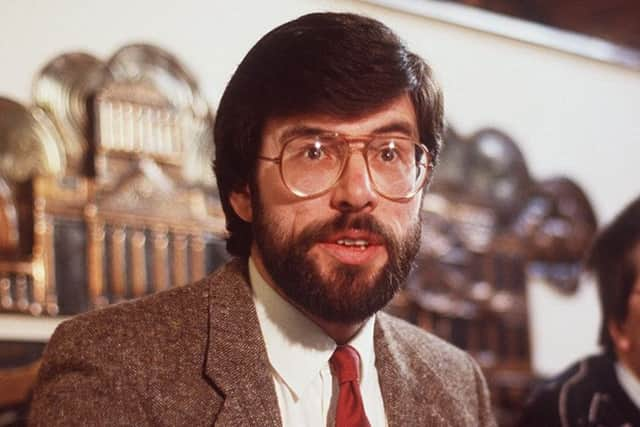Declassified files: Government was livid at Gerry Adams visa U-turn by Bill Clinton
and live on Freeview channel 276
In what was to be a seminal decision, President Bill Clinton decided to allow the Sinn Fein president to visit for 48 hours, despite the advice of key US security agencies and individuals that his request for a visa should be rejected because of his links to the IRA.
Just weeks earlier, London and Dublin had agreed the Downing Street Declaration, an important step on the long road towards what four years later would become the Belfast Agreement.
Advertisement
Hide AdAdvertisement
Hide AdIt is clear from the newly declassified files at the Public Record Office in Belfast that the government put enormous effort into attempting to keep Mr Adams out of the US.


The UK’s inability to prevent the Sinn Fein leader travelling to America was not only a significant failure of British diplomacy, but signalled the limitations of what London could achieve with its closest ally when they disagreed on Northern Ireland.
On January 27 1994, three days before it emerged that Mr Adams had succeeded in securing the visa, prime minister John Major’s private secretary, Roderic Lyne, set out the latest position in a confidential memo to the secretary of state’s private secretary.
The Downing Street official said that US national security advisor Tony Lake had phoned him to advise that a decision had been taken to grant Mr Adams a visa on the basis of conditions which he said had been relayed to the government five days earlier.
Advertisement
Hide AdAdvertisement
Hide AdMr Lyne – who would go on to become British ambassador to Moscow – said that he had “argued vigorously against Lake’s formula” and the US official had phoned back an hour later “with a much improved formula”.
That was followed by “further improvements” after a conversation between the foreign secretary and US secretary of state Warren Christopher. He said: “As of 1930 this evening, the Americans appear to have decided on the following: “instructions are issuing (I think to Dublin rather than Belfast) that the Consul General is to invite Adams to a meeting on the morning of Friday 28 January; Adams will be asked to [say] in a public statement that: he personally renounces violence and will work to that end [and] Sinn Fein and the IRA are committed to ending the conflict in Northern Ireland on the basis of the Joint Declaration.
“Adams will be told that if he accepts this formula it will help the US Government’s decision over his visa.”
That same day Jonathan Stephens – then the private secretary to the secretary of state but now the NIO’s most senior official – recounted a conversation between the foreign secretary and Mr Lake that day during which Mr Lake had said that President Clinton had agreed to offer a visa subject to quite weak conditions. Since then, Mr Stephens said, there had been “a fierce rearguard action by the State Department” which resulted in conditions being attached to the offer of a visa.
Advertisement
Hide AdAdvertisement
Hide AdHowever, it quickly became clear that Mr Adams was not prepared to publicly renounce violence – and the US was going to back down. It was reported at the time that although the UK opposition to the visa was forthright, that view “has carried less weight in Washington since the disclosure of [British government] talks with Sinn Fein”.
A February 1 1994 telegram from the British Ambassador to Washington, Sir Robin Renwick, said that “I think we have now done all possible lobbying here. The administration, to put it mildly, have been left in no doubt of our views”.
He said that the US secretary of state had told him that he had argued against Mr Adams getting a visa and that at the Embassy’s request the House Speaker, Tom Foley, had spoken to the president directly about the issue. The FBI and the US attorney general opposed the visa.
The same day, the US Ambassador to London, Ray Seiz, was asked to visit Downing Street for a meeting which the British did not publicise at the time but which indicated the strain which the issue had put on US-UK relations. During the meeting with the ambassador – who had argued against the visa – Mr Lyne told him that “Gerry Adams did not meet the two points which we understand were put to him by the United States government on 28 January. He has not renounced violence. Indeed, he is already using his visit to the US as a platform to propagandise his justification of IRA terrorism.” He said that the government was “dismayed that our warnings were not taken into account”.
Advertisement
Hide AdAdvertisement
Hide AdFiles released at the National Archives in Kew contain a blistering note from Mr Lyne to Mr Lake which said: “The movement in which Gerry Adams has long been a leading figure has murdered not only thousands of its own countrymen, but also ... small children in our shopping centres.”
The note from Mr Lyne to Mr Lake added: “It is sad, paradoxical, and misguided of the Kennedys, having lost two brothers to acts of terror, to be pressing you to admit a terrorist leader without an end to terrorism or even a commitment to end terrorism”.
There was also a suggestion from Australia that Mr Adams may be allowed to visit in light of the US visa. Mr Lyne scrawled on the document: “I hope the Aussies realise this would be the end of Anglo/Australian relations!” Mr Adams was denied entry to Australia in 1996 but visited in 1999.